- HOME
- Who We Are
- How We Do
- Where We Work
- Stay Informed
- COAST Staff in Action
- Training Materials
- Project Completion Report
- Publications
- Circular
- Plans and Audit Reports
- Notice
- Meeting Minutes
- Recruitment Forms and Joining Process
- Terms of Reference
- Evaluation and Review
- COVID-19 Document
- MTCP-2 Project
- Contact
- Location


